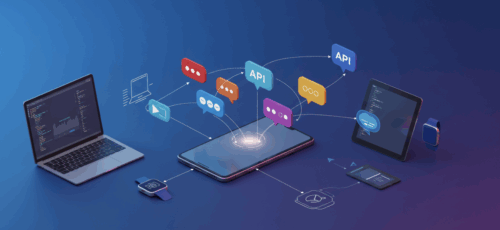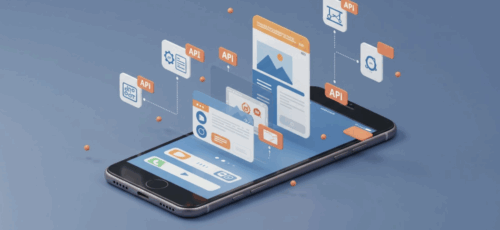Messaging APIs transform customer engagement by delivering high open rates and enabling real-time, personalized communication at scale.
- Enable two-way conversations that increase customer satisfaction.
- Automate critical touchpoints like appointment reminders and transaction alerts.
- Integrate seamlessly with existing systems using simple REST APIs.
- Support multiple channels (SMS, MMS) for rich, interactive experiences.
For developers, messaging APIs offer the fastest path to building engagement-driven applications that customers actually use.
Customer engagement has become the defining factor between applications that thrive and those that fade into obscurity. While traditional communication channels struggle with declining open rates and delayed responses, messaging APIs are revolutionizing how businesses connect with their users. For developers tasked with building applications that genuinely engage users, understanding how API integration can transform customer relationships is essential.
The shift toward mobile-first communication has created unprecedented opportunities for developers to build more responsive, interactive applications. With consumers checking their phones over 160 times daily, messaging APIs provide the infrastructure needed to meet users where they already are: on their mobile devices.
What Makes Messaging APIs Essential for Customer Engagement?
Modern customer engagement demands immediacy, personalization, and reliability, requirements that traditional communication channels can’t meet at scale. A messaging API serves as the bridge between your application’s business logic and the telecommunications infrastructure needed to deliver messages instantly to users worldwide.
The Engagement Gap Traditional Channels Can’t Fill
Email marketing, once the cornerstone of digital customer engagement, now faces significant challenges. Average email open rates hover around 42%, but they don’t necessarily lead to engagement or conversions. Push notifications, while more immediate, are easily disabled by users and often get lost in notification overload. Voice calls, though personal, are increasingly intrusive and time-consuming for both businesses and customers.
Text messaging, however, maintains exceptional performance metrics that developers can leverage. Studies show that 90% of text messages are read within three minutes of delivery, with response rates reaching 45%. This dramatic difference in engagement stems from the personal, immediate nature of SMS communication and the universal accessibility of text messaging across all mobile devices.
Why Developers Choose API-First Messaging Solutions
For development teams, building messaging capabilities from scratch presents technical challenges. Managing carrier relationships, ensuring message deliverability across different networks, handling compliance requirements, and maintaining infrastructure reliability requires specialized telecommunications expertise that most development teams lack.
Messaging APIs eliminate these complexities by providing a programmatic interface to enterprise-grade messaging infrastructure. With just a few lines of code, developers can integrate SMS API, MMS API, and other business communication API functionality into their applications, enabling sophisticated messaging workflows without the overhead of managing telecommunications infrastructure.
How Do Messaging APIs Drive Higher Engagement Rates?
The superior engagement rates delivered by messaging stem from three fundamental advantages: immediacy, personalization, and the inherent interactivity of messaging platforms.
Real-Time Communication That Customers Actually See
Unlike email or push notifications that can be easily ignored, text messages command immediate attention. The combination of audio notifications, lock screen visibility, and the habitual nature of checking text messages ensures that your application’s communications reach users when they matter most.
This immediacy proves particularly valuable for time-sensitive communications. Whether confirming a transaction, alerting users to security concerns, or providing real-time updates about service status, messaging APIs ensure critical information reaches users instantly. Businesses using SMS for customer communication see 217% higher success rates compared to those relying solely on traditional channels.
Personalization at Scale Through Data Integration
Modern messaging APIs support dynamic content insertion, allowing developers to create highly personalized messages using customer data from CRMs, user databases, or application-specific information. Personalization transforms generic broadcasts into relevant, contextual communications that drive engagement.
For example, an e-commerce application might integrate customer purchase history with an API to send personalized product recommendations, while a healthcare platform could use patient data to deliver customized appointment reminders with relevant preparation instructions. This level of personalization, delivered through the immediate channel of text messaging, increases user engagement and response rates.
Two-Way Conversations That Build Relationships
Unlike traditional one-way communication channels, messaging APIs enable interactive conversations between applications and users. This bidirectional capability allows businesses to gather feedback, provide customer support, and create engaging experiences that foster deeper customer relationships.
Two-way SMS messaging improves customer engagement through surveys and feedback collection, enabling businesses to understand customer preferences and iterate on their offerings. The conversational nature of messaging also supports complex workflows, such as appointment scheduling, order modifications, or troubleshooting assistance, all within the familiar interface of text messaging.
What Are the Key Implementation Benefits for Developers?
From a technical perspective, messaging APIs offer several advantages that make them attractive for developers building customer-facing applications.
Simple Integration with Existing Systems
Modern messaging APIs use REST architecture and support multiple programming languages, making integration straightforward for development teams. Most SMS API providers offer comprehensive documentation, SDKs for popular languages like Python, Ruby, and Node.js, and sandbox environments for testing implementations before going live.
A basic SMS integration typically requires just a few lines of code:
python
This simplicity allows developers to focus on building engaging user experiences rather than managing telecommunications complexity.
Scalable Architecture for Growing Applications
Business communication API platforms are built to handle enterprise-scale message volumes, automatically scaling to accommodate growing user bases without requiring infrastructure changes from development teams. Whether sending hundreds or millions of messages, the underlying API infrastructure handles load balancing, carrier routing, and delivery optimization transparently.
This scalability proves essential for applications experiencing rapid user growth or seasonal usage spikes. Developer teams report improved efficiency when using established messaging APIs compared to building messaging infrastructure in-house, primarily due to the reduced operational overhead and automatic scaling capabilities.
Built-in Security and Compliance Features
Enterprise-grade APIs include comprehensive security features such as TLS encryption, webhook signature verification, and audit logging. Many providers also offer compliance tools for regulations like GDPR, HIPAA, and industry-specific requirements, reducing the compliance burden on development teams.
These built-in security features prove particularly valuable for applications handling sensitive data or operating in regulated industries. Rather than implementing security measures from scratch, developers can leverage tested, certified infrastructure that meets enterprise security standards.
Top Messaging API Use Cases That Boost Engagement
Successful API implementations typically focus on specific use cases that deliver immediate value to users while driving measurable engagement improvements:
- Appointment Reminders and Confirmations: Automated SMS reminders reduce no-show rates while improving customer satisfaction through proactive communication.
- Real-Time Transaction Alerts: Instant notifications for purchases, payments, or account changes build trust and provide security reassurance that encourages continued platform usage.
- Two-Factor Authentication Flows: SMS-based 2FA delivers security without friction, with over 55% of consumers preferring SMS for authentication over app-based alternatives.
- Customer Support Automation: Intelligent chatbots powered by messaging APIs can handle routine inquiries while seamlessly escalating complex issues to human agents.
- Marketing Campaigns with High Open Rates: Targeted promotional messages achieve higher engagement rates than email campaigns, with the ability to include rich media through MMS API integration.
- Event Notifications and Updates: Real-time alerts about service disruptions, feature releases, or time-sensitive opportunities ensure users stay informed and engaged with your platform.
How to Choose the Right Messaging API for Maximum Engagement
Selecting the best messaging API provider requires evaluating several technical and business factors that directly impact engagement outcomes.
Developer-Friendly Features to Look For
The best messaging APIs prioritize developer experience through comprehensive documentation, multiple SDK options, and responsive technical support. Look for providers offering REST APIs compatible with popular programming languages, webhook support for real-time event handling, and detailed message delivery reporting that enables engagement optimization.
Sandbox environments and testing tools allow developers to validate implementations before deploying to production, while clear error handling and status codes simplify troubleshooting and monitoring. The availability of code samples, quickstart guides, and integration tutorials can significantly reduce implementation time and ensure best practices are followed.
Integration Capabilities and Documentation Quality
Evaluate how well potential messaging API providers integrate with your existing technology stack. Leading platforms offer pre-built integrations with popular CRM systems, marketing automation tools, and customer support platforms, reducing custom development requirements.
Documentation quality directly impacts development velocity and long-term maintenance requirements. Comprehensive API references, detailed integration guides, and active developer communities indicate providers committed to supporting successful implementations.
Scalability and Reliability Considerations
Engagement-focused applications require messaging infrastructure that can scale with user growth while maintaining consistent performance. Evaluate providers based on their global coverage, carrier relationships, and redundancy measures that ensure message delivery even during network disruptions.
Service level agreements (SLAs) for message delivery times, uptime guarantees, and support response times provide measurable commitments to the reliability your application requires. Advanced platforms offer features like automatic failover routing and multi-carrier redundancy that protect against service disruptions that could impact customer engagement.
Frequently Asked Questions
How quickly can messaging APIs be integrated into existing applications? Most developers can complete basic SMS API integration within a few hours using REST APIs and provided SDKs. More complex implementations involving webhooks, two-way messaging, or CRM integration typically require one to two weeks, depending on system complexity and customization requirements.
What engagement metrics can developers track with messaging APIs? Comprehensive messaging platforms provide detailed analytics, including delivery rates, open rates, response rates, opt-out rates, and conversion tracking. Advanced platforms also offer engagement scoring, campaign performance comparisons, and user journey analytics that help optimize messaging strategies.
Which messaging channels offer the best ROI for customer engagement? SMS consistently delivers the highest ROI among digital channels, with high open and response rates. MMS APIs can further enhance engagement for visual content, while maintaining the immediacy and reliability that make text messaging uniquely effective.
Transform Customer Engagement with Strategic Messaging API Implementation
For developers building applications that need to capture and maintain user attention, messaging API integration provides the technical infrastructure and engagement capabilities necessary to succeed.
The combination of immediate delivery, high open rates, and interactive capabilities makes SMS and MMS APIs essential tools for any application focused on customer engagement. Whether implementing simple notification systems or building complex conversational experiences, the right API partner can dramatically improve how your users interact with your application. Get started with Flowroute’s developer-friendly messaging APIs and discover how easy it is to build communication features that your customers will actually use.

Mitch leads the Sales team at BCM One, overseeing revenue growth through cloud voice services across brands like SIPTRUNK, SIP.US, and Flowroute. With a focus on partner enablement and customer success, he helps businesses identify the right communication solutions within BCM One’s extensive portfolio. Mitch brings years of experience in channel sales and cloud-based telecom to every conversation.






